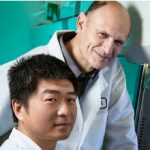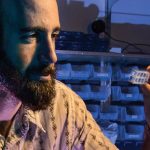‘Superhero’ microbiome bacteria protect against deadly symptoms during infection
As concerns over deadly antibiotic-resistant strains of ‘superbug’ bacteria grow, Janelle Ayres and colleagues are offering a possible solution to the problem: ‘superhero’ bacteria that live in the gut and move to other parts of the body to alleviate life threatening side effects caused by infections.
In a paper published October 30, 2015 in Science, Ayres’ lab reported finding a strain of microbiome Escherichia coli bacteria in mice capable of improving the animals’ tolerance to infections of the lungs and intestines by preventing wasting—a potentially deadly loss of muscle tissue that occurs in serious infections. If a similarly protective strain is found in humans, it could offer a new avenue for countering muscle wasting, which afflicts patients suffering from sepsis and hospital acquired infections (many of which are now antibiotic resistant).
The Salk team identified a population of laboratory mice that appeared resistant to muscle wasting. By comparing the makeup of the intestinal microbiomes of these mice to mice that lacked resistance, the team identified a strain of E. coli that was present only in the wasting-resistant mice. When normal mice were given an oral treatment of this beneficial E. coli strain, they gained the ability to maintain their muscle and fat mass during intestinal infections and pneumonia.
Collaborating with the laboratory of Ronald Evans, the scientists discovered that during an infection by the pathological bacteria, the E. coli left the gut and moved into the fat tissues to induce protective responses that nourish the muscles. Normally, mice with lung and intestinal infections see a drop in a hormone known as insulin like growth factor 1 (IGF-1), a molecule that signals the body to retain muscle mass. But the protective E. coli activated the IGF-1 pathway in the fat tissues, preserving normal IGF-1 levels and maintaining the animal’s muscle in spite of the pathogenic infections. The team will investigate how long this E. coli strain can hold off the pathogens; whether the body’s immune system will eventually eradicate the harmful bacteria completely; and if such a microbe exists in humans.
Read News ReleaseFeatured Stories
 Frontiers in Regenerative MedicineWhen Juan Carlos Izpisua Belmonte and his team at Salk made global news headlines last fall for developing a technique for growing...
Frontiers in Regenerative MedicineWhen Juan Carlos Izpisua Belmonte and his team at Salk made global news headlines last fall for developing a technique for growing... Next Gen: Zachary KatzZachary Katz is a visual person: from insect-devouring plants to bustling cells, he strives to see what happens in nature. While growing up in Arizona and then Florida, Katz and his brother gathered...
Next Gen: Zachary KatzZachary Katz is a visual person: from insect-devouring plants to bustling cells, he strives to see what happens in nature. While growing up in Arizona and then Florida, Katz and his brother gathered... An Interview with Salk President Elizabeth BlackburnWhen Jonas Salk announced the discovery of the polio vaccine in 1955, Elizabeth Blackburn was six years old and busy collecting...
An Interview with Salk President Elizabeth BlackburnWhen Jonas Salk announced the discovery of the polio vaccine in 1955, Elizabeth Blackburn was six years old and busy collecting...




















































